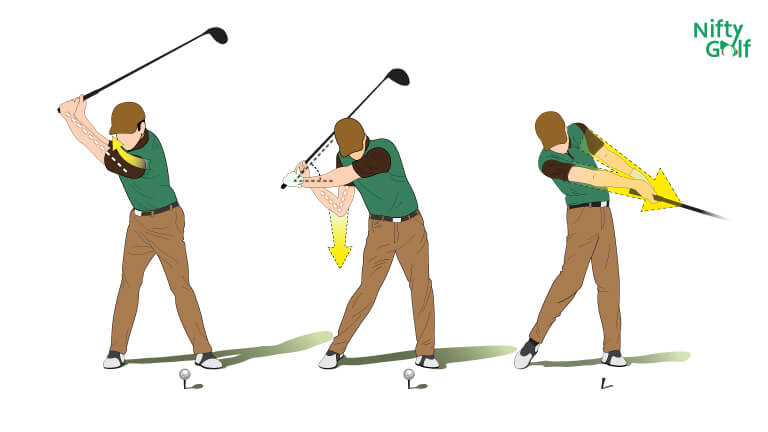Golfers are often obsessed with the term swing lag or lag shot in the golf swing. It’s a strategy that offers increased clubhead speed, extra force on impact, and long distance. Creating a lag in golf is a skill that can distinguish between an amateur and an expert. As valuable as it sounds, a lag can be hard to learn. It takes split-second precision and proper body movement to create a perfect lag. If you want to learn how to create lag and how it can benefit your game, this article is for you.
Table of Content
What is Golf Swing Lag?
A lag is the trailing of a golf club during a downswing. When your hands trail to an extent before making a downswing, they create a lag. You must hold the angle between your lead arm and the club shaft for a while to get the most out of a lag. It will extend and twist your lower body, giving it a “pull” feeling.
Now you release this tension in your lower body, turning it in the forward and use the movement to execute the downswing. You get a whip-like motion to hit the ball with more clubhead speed. The timing is the key here. Releasing the club early is a mistake committed mostly by amateurs. The more accurate your timing of releasing the club is, the better the output you will get from the lag.

To master the art of swing lag in your game, you must understand it first. But you must know the purpose of creating lag and how it affects your game before you use it. For many golfers, the only objectives of creating a lag are gaining extra club speed and covering a longer distance. But there is much more a perfect lag can offer.
In the simplest words, lag is stored energy waiting to make an impact. The energy gets released when the club hits the ball. World-class PGA Tour golfers like Ben Hogan, Sergio Garcia, and many more can ideally create and release incredible lag. No wonder he is globally acclaimed as one of the best golf ball strikers.
Why Should You Create Lag?
Lag is essential for several reasons. The first reason is to produce a far higher rate of clubhead speed than you would have achieved without lag. The speed of your clubhead is what brings distance to your golf swing. This indicates that your clubface is contacting the ball quicker and transferring more swing energy, which translates into longer distances when you hit the ball.
Because lag makes it possible for a clubhead to reach the bottom of the swing at precisely the appropriate time, it also results in more consistent ball striking. And the more consistent you are on the golf course, your scores will be lower. If you want to improve your driving distance, accuracy, and shots’ consistency, you should work on adding lag into your golf swing and practice doing so.
How to Create Lag in Golf Swing?
Your body will relax from the ground up in an ideal lag position. You will move your hip for power while keeping your wrists and wrist hinge stationary. Your upper torso will rotate then, allowing your arms to slide into the right position. When you create a perfect lag, you will feel that the clubhead’s weight exerts some force on the club shaft.
Creating a lag is one of the most effective techniques to enhance swing speed at contact. More speed provides more distance. And to get to that point, you must practice different strategies. Here are a few:
- The first piece of strategy is to lead the downswing with your left side. You should let the right arm and shoulder only support the golf club. Make sure they are not leading it. When you let the left side dominate the swing, producing substantial lag in a golf swing becomes considerably easier. Just implant the idea in your mind that the right side of your body is there just to enjoy the ride. It is there only to support the club, to let your left side take care of the rest.
- Another great strategy to get a good lag has a light grip. This might be a game-changer for a downswing. You can hold the lag angle longer with a gentle grip on the club. It will help you release the lag and make a timely impact. You should grasp the club strongly enough to have control without impeding its backswing or downswing.
- When aiming to produce additional distance with your shots, turning your shoulders a complete 90 degrees is essential. Even if you lack flexibility, you should be able to swivel your shoulders 90 degrees to increase the distance of your shots. Lastly, you should strive to produce the broadest possible swing arc by keeping your arms straight during the backswing and takeout. This will work if you keep a straight left arm throughout the swing, regardless of size.
Why Should You Create a Lag Shot in Golf?
Lag is essential for several reasons. The first reason is to produce a far higher rate of clubhead speed than you would have achieved without lag. The speed of your clubhead is what brings distance to your golf swing. This indicates that your clubface contacts the ball quicker and transfers more swing energy, translating into longer distances when you hit the ball.
Because lag makes it possible for a clubhead to reach the bottom of the swing at precisely the appropriate time, it also results in more consistent ball striking. And the more consistent you are on the golf course, the lower your scores will be. If you want to improve your driving distance, accuracy, and shots’ consistency, you should work on adding lag into your golf swing and practice doing so.
Exercises to Improve Your Lag Skill
The best exercise will be the one-handed drill. Right-handers will use their right hands, and left-handers will use their left hands. Hold the club with your leading hand and create a swing as if you were doing it with your two hands. You can feel the lag created by the clubhead. Now keep improving the swing speed. Here are a few more tips to help you create more energetic lag.
Use a weight: Put something like a weighted donut on the edge of your clubhead. You will instantly feel the difference. The extra weight will get you to build up more speed.
Feet Together Drill: Make a difference by addressing the golf ball with your feet instead of making the regular golf stance. Now take full swing. While doing so, you will see you can’t use the lower body. This will motivate you enough to create lag to ensure the necessary force. It will soon help you create the needed lag and speed.
Whip Force: Just flip the club totally upside down and hold it. Just make regular swings but put focus on it. There should be a sound of the club whipping into the air. Pay attention and analyze the sound. You should hear the sound at the impact point. It is the demonstration of the fact you have gained the maximum speed at the point of contact.
Conclusion
Visualizing a club trailing behind your body and executing a perfect downswing from there to produce clubhead speed is tricky. That’s why you can find the lag concept challenging to understand. You might even give up learning and practicing it. However, if you work on the techniques and master them, you will undoubtedly be able to take the ball further, improve accuracy, and become more consistent. As a player who has mastered swing lag in golf, you will feel more power and enjoy the game more than ever.

